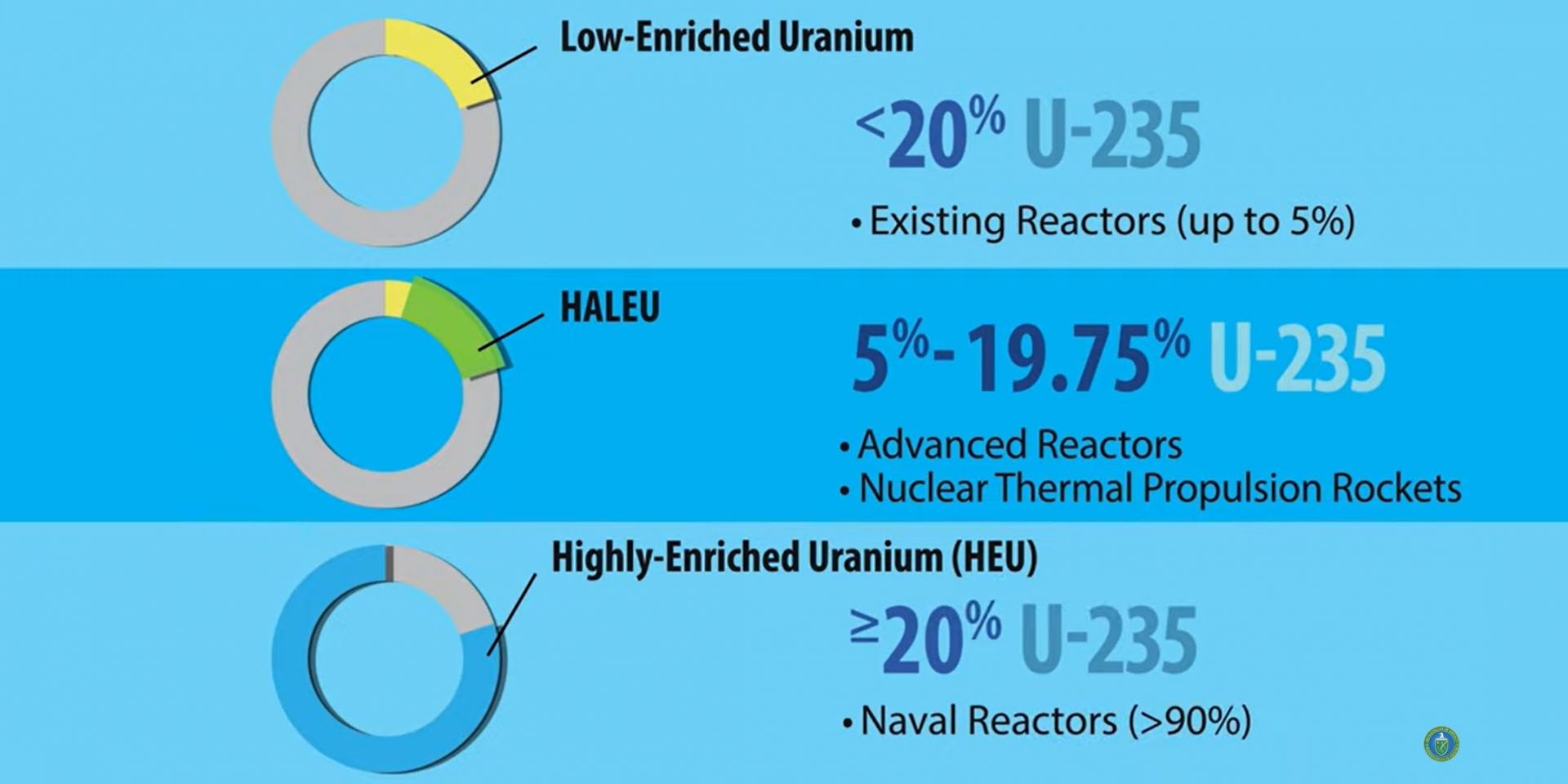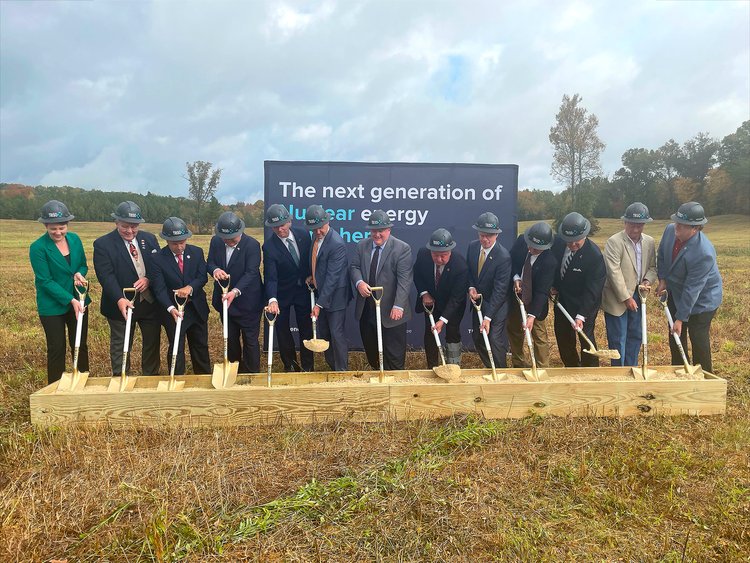An image from the video “What is High-Assay Low-Enriched Uranium (HALEU)?” released by the DOE in April 2020. (Source: DOE)
Another piece of the plan for meeting the urgent need for high-assay low-enriched uranium (HALEU) to fuel advanced reactor deployments fell into place when the Department of Energy held an Industry Day on October 14. Attendees were asked how soon they could deliver 25 metric tons per year of HALEU enriched in the United States from newly mined uranium. Offtake contracts for six or more years of HALEU production at that rate could be used to stock a DOE-owned HALEU bank to “support [HALEU] availability for civilian domestic research, development, demonstration, and commercial use.”
The Integrated Effects Test at TerraPower’s laboratory in Everett, Wash. (Photo: Southern Company/TerraPower)
“The world's largest chloride salt system developed by the nuclear sector” is now ready for operation in TerraPower’s Everett, Wash., laboratories. Southern Company, which is working with TerraPower through its subsidiary Southern Company Services to develop molten chloride reactor technology, announced on October 18 that the Integrated Effects Test (IET) was complete. The multiloop, nonnuclear test infrastructure follows years of separate effects testing using isolated test loops, and it was built to support the operation of the Molten Chloride Reactor Experiment (MCRE) at Idaho National Laboratory that the companies expect will, in turn, support a demonstration-scale Molten Chloride Fast Reactor (MCFR).
The Neckarwestheim nuclear power plant in Germany. (Photo: EnBW)
German chancellor Olaf Scholz has provided what appears to be the final word on the fate of his country’s three remaining operating nuclear power plants.
Via an October 17 letter, Scholz informed economy and energy minister Robert Habeck, environment minister Steffi Lemke, and finance minister Christian Lindner of his decision to keep all three facilities operating “beyond 31 December 2022 until 15 April 2023 at the latest.” The order ends months of argument between Scholz’s two coalition partners—the stridently antinuclear Greens and the center-right Free Democrats (FDP)—regarding the plants’ continued operation. (Habeck and Lemke are Green Party members, while Lindner is with the FDP.)
Workers dismantle the conveyors of a coal-handling system at the Savannah River Site’s D Area. (Photo: SRNS)
Workers at the Department of Energy’s Savannah River Site have achieved an 85 percent reduction in the site’s operational footprint, a percentage that will grow as decommissioning and demolition of facilities continue in the site’s massive D Area, according to the DOE.
Virginia Gov. Glenn Youngkin announces a $10 million energy innovation investment in Virginia. (Photo: Christian Martinez/Office of the Governor)
Some two weeks after unveiling his state’s 2022 Energy Plan, Virginia Gov. Glenn Youngkin has announced his intention to include $10 million in the state’s next budget proposal—due in December—to create the Virginia Power Innovation Fund for research and development of nuclear, hydrogen, carbon capture and utilization, and battery storage technologies.
Government officials and representatives of X-energy and its TRISO-X subsidiary at the October 13 groundbreaking. (Photo: X-energy)
Leaders of X-energy and its TRISO-X subsidiary gathered on October 13 to break ground at the site of what X-energy bills as “North America’s first commercial-scale advanced nuclear fuel facility” in Oak Ridge, Tenn. X-energy expects the TRISO-X Fuel Fabrication Facility (TF3) to create more than 400 jobs and to be commissioned and operational by 2025.
Caption. (All photos: Duke Energy)
Duke Energy’s Harris nuclear power plant’s 24th refueling outage began in early October. The plant, located in New Hill, N.C., is a 964-MWe Westinghouse three-loop pressurized water reactor that started commercial operation in May 1987.
Vogtle Unit 3 in September. (Photo: Georgia Power)
Georgia Power announced this morning that fuel loading at Vogtle-3 has commenced, marking an important milestone on what has proved to be a long and bumpy road to startup and commercial operation of the first new nuclear power reactors to be built in the United States in more than three decades. (Major work on the Vogtle-3 and -4 project began in 2012, with a price tag of $14 billion and scheduled unit start dates of 2016 and 2017. The project’s total cost is now expected to exceed $30 billion.)
From left: Czech Republic deputy minister of industry and trade Petr Třešňák, ČEZ’s Tomáš Pleskač, OPG’s Ken Hartwick, Ontario minister of energy Todd Smith, and Canadian ambassador to the Czech Republic Ayesha Patricia Rekhi. (Photo: CNW Group/Ontario Power Generation)
Canada’s Ontario Power Generation (OPG) and Czech Republic–based ČEZ have agreed to collaborate on nuclear technology deployment, including small modular reactors, under a memorandum of understanding signed yesterday in Prague.
Ontario’s largest electricity generator and the European energy giant have both pledged to achieve net-zero carbon emissions by 2040.
G. Robert Keepin, of Los Alamos Scientific Laboratory, author of a three-part feature on the IAEA published in Nuclear News in January, February, and March of 1966; the cover of the January 1966 issue, featuring the IAEA’s first headquarters in the Grand Hotel of Vienna, Austria; and a February 1966 IAEA photo of remote handling of radioisotope standard sources at the Seibersdorf laboratory.
A groundbreaking ceremony held last week at the International Atomic Energy Agency’s laboratories in Seibersdorf, Austria, marked the start of construction on a nuclear applications building that will host three state-of-the-art laboratories: Plant Breeding and Genetics, Terrestrial Environment and Radiochemistry, and Nuclear Science and Instrumentation.It was a significant achievement for the second phase of the Renovation of the Nuclear Applications Laboratories initiative, known as ReNuAL2—and a fitting way to observe the 60th anniversary of the nuclear applications laboratories at Seibersdorf, about an hour’s drive south the IAEA’s headquarters in Vienna. For Nuclear Newswire, it was all the reason we needed to dig into the Nuclear News archives and explore the bygone days of research at the IAEA.
An aerial view of ORNL’s main campus. (Photo: ORNL)
The Gateway for Accelerated Innovation in Nuclear (GAIN) announced the three recipients of its fourth and final round of 2022 vouchers on October 10. The vouchers were awarded to Curio Solutions, which is developing a spent fuel recycling process, and to two companies that are separately investigating advanced reactor siting—Elementl Power and the Tennessee Valley Authority (TVA). The funds for each award will go directly to Oak Ridge National Laboratory.
Cameco headquarters in Saskatoon, Saskatchewan, Canada. (Photo: Cameco)
Five years after bankruptcy, Pennsylvania-based Westinghouse is being sold again, this time with a 49 percent share going to Cameco Corp., the front-end uranium mining, milling, and conversion company headquartered in Saskatchewan, Canada. Cameco and Brookfield Business Partners, based in Toronto, Ontario, announced the deal yesterday. Once it closes as expected, in the second half of 2023, Brookfield Renewable Partners and other Brookfield institutional partners will own a 51 percent interest in a consortium with Cameco.
The Trawsfynydd site in North Wales. (Photo: Magnox Ltd.)
The United Kingdom’s Nuclear Decommissioning Authority (NDA) has announced the signing of a memorandum of understanding with Cwmni Egino to support the development of a small-scale nuclear project in North Wales.





















